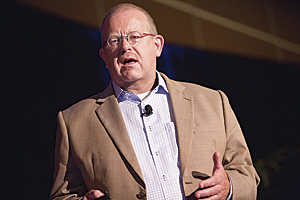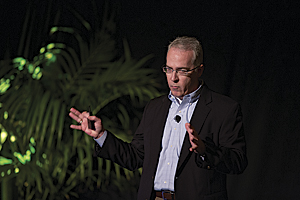ArcUser
Fall 2012 Edition
Keeping Service Levels High and Costs Low
By Karen Richardson, Esri Writer
This article as a PDF.
"Using location analytics significantly changes your insights into the future—you get an understanding of where you came from and find out where you want to go," said Bruce Wong, manager of advanced network analytics at General Motors (GM) Company as he spoke at the Plenary Session of the 2012 Esri Business Summit, held July 22–24 in San Diego, California.

Rob Bakker of the insurance and financial services firm Achmea stressed the importance of thinking about old things in new ways.
The Esri Business Summit brings some of the best minds in business together to share how commercial organizations worldwide are using place-based decision making to support customer service, grow profitability, and manage change in an increasingly complex world. Nearly 400 attendees listened to plenary speakers in the morning and then attended focused sessions on topics such as using GIS for better customer service, retail applications, and spatial modeling for better growth.
Being in the Best Place
Wong was the first of several plenary speakers. He began the morning talking about how important it is for GM to understand and improve its business analytics. The company transformed itself, going from bankruptcy to profitability and posting $1 billion in first quarter profits this year. Wong said the company has been using more GIS analytics to trim fat and become more fiscally fit.
Dr. Wayne M. Gearey Jr., senior vice president of location intelligence at Jones Lang LaSalle, reiterated Wong's emphasis on location and added that location intelligence is the game changer. "Using location analytics, we can define our data filters to understand the best location based on what the business ecosystem looks like," said Gearey. "This is important because our ultimate goal is to get our clients to a geography of opportunity using the right people, data, and technology. As a result, we build trust and they come back again and again."
Knowing What the Customer Needs and Wants
Rob Bakker, knowledge manager at Achmea, an insurance and financial services firm in the Netherlands, stressed that it is imperative for business managers to think about old things in new ways. Achmea's use of GIS has led to streamlining processes for its 18,000 employees, cutting costs, and innovating new products.
While neither a GIS expert nor a practiced public speaker, Bakker said he felt compelled to share Achmea's success using GIS for risk management, more efficient business processes, and transparency to both government authorities and its customers.
"Achmea has a complex structure—many labels and brands," explained Bakker. "We have divisions in health, banking, real estate, life and pensions, and non-life. Each division has its own dynamics and methods of product distribution."
Working on priority key performance indicators for each of these divisions, Bakker's GIS team was able to build business cases showcasing the effectiveness of GIS for diverse business functions. "One tenet is to be a leader in our industry," said Bakker. "So, we focused on social solidarity and created a pilot project with the City of Eindhoven [in the south of the Netherlands] to help them measure rainfall and mitigate flooding. That translates to creating a digital underwriting map for the reduction of unknown risk accumulation. By doing this, we talk the same language as the decision makers and connect GIS to the strategic goals of our business."
Using GIS, Achmea managers believe they also have a better view on underwritten fire risks and thus are more effective in their risk management. Having this common operational picture for the underwriters of several Achmea brands is more efficient and competitive. It makes claims data available for customers, increasing the company's transparency, and allows Achmea staff to develop products and services that make them an insurer that customers can depend on.
Dependable and Nondisruptive
Interstate Batteries leverages GIS to enhance its outrageously dependable service model. A $1 billion, privately held company, Interstate Batteries relies on a vast network of dealers to sell its products and provide spent batteries for recycling. Esri technology is at the center of its efforts to maximize the efficiencies of Interstate Batteries distributors as they serve supported dealers. "Esri mapping technology serves as the glue of our best-of-breed CRM [customer relationship management], business intelligence, and master data management solution by providing a visual delivery mechanism for distributor route fulfillment. At Interstate Batteries, we strive to serve our distributors and dealers with the best products and business/technology solutions, including opportunities to make GIS useful and effective," said Mike Darr, program manager for Interstate Batteries' Market IQ Program. "Before you know it, you'll have the user looking at data in ways he never pictured it and uncovering previously unknown opportunity."

"Look for the simple opportunities to make GIS useful and effective," said Mike Darr, program manager for Interstate Batteries' Market IQ Program. "Before you know it, you'll have the user looking at data in ways he never pictured it."
Other plenary speakers during the morning session included Felma Degefa, senior staff engineer at Kohler Co.; David Kniffin, business manager for 3M Traffic Safety Systems; and Sudhir Potharaju, vice president of software development for AIR Worldwide. They emphasized the need to keep projects small and simple and take care not to be a business interrupter that changes the way that managers work.
Keeping Service Levels High
Adam Kostecki, a claims examiner in the Property Loss Division at Amica Mutual Insurance, extended this train of thought in his afternoon breakout session "Pushing GIS to the Front Lines to Improve Customer Service." Amica, headquartered in Lincoln, Rhode Island, is a provider of personal insurance for autos, homes, and boats. Known in the industry for its high standard of customer service, the company has been awarded several J.D. Power and Associates customer satisfaction awards.
During the presentation, Kostecki demonstrated how Amica uses GIS after hailstorms, tornadoes, and wildfires to proactively respond to policyholders' needs. In one compelling example, Kostecki showed how local branch users kept policyholders informed during the High Park and Waldo Canyon wildfires in Colorado. During the height of these fires, tens of thousands of homes were under mandatory evacuation. Some people couldn't access their homes for days. Amica used GIS technology and up-to-date satellite images to notify some policyholders that their homes were still standing.
"They saw smoke and flames approaching as they evacuated and had no idea if they would have a home to return to," Kostecki explained. "Our policyholders were amazed we had access to this technology. They really appreciated these updates."
Kostecki also showed examples of how GIS could be used during the claims adjustment process to improve efficiency and lower expenses. "With GIS, we have a much better idea of what our claim potential is going to be after an event," he said. "In the past, it might have taken days to fully understand the magnitude of an event. Now our branch users can generate reports with a few mouse clicks, and they can do this in real time as the event is occurring."
Breakout sessions and Lightning Talks filled the balance of the afternoon. The day ended with a poolside social at the Omni San Diego Hotel, courtesy of Gold sponsor Microsoft and silver sponsors AccuWeather, CloudTrigger, i-cubed, Nokia, and TomTom.
For information on next year's Esri Business Summit, visit esri.com/bizsummit.